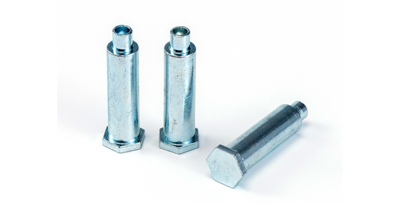What Are Blind Rivets?
Blind Rivets, also known as pop rivets, are mechanical Fasteners designed for joining materials where access is limited to only one side. They consist of two primary components: a hollow rivet body (typically 3–10 mm in diameter) and a mandrel (0.8–4 mm in diameter). The installation process involves inserting the rivet into pre-drilled holes and using a specialized tool to pull the mandrel, which deforms the rivet body to create a secure joint. Unlike solid rivets, Blind Rivets require 60–80% less installation force (typically 200–800 N) while achieving comparable shear strength (up to 5,000 N for steel variants).

Key Features with Technical Data
1. One-Side Installation
Blind rivets can be installed from a single side, making them ideal for applications where the rear is inaccessible. The grip range (material thickness capacity) varies from 0.5 mm to 12 mm, with multi-grip rivets accommodating variable thicknesses within ±1 mm tolerance.
2. Material Versatility
Common materials include:
Aluminum (AA5056/AA5052): Tensile strength 180–300 MPa, weight 2.7 g/cm³
Stainless Steel (A2/A4): Corrosion resistance up to 1,500 hours salt spray, shear strength 3,200–5,000 N
Monel: Nickel-copper alloy with 550 MPa tensile strength, used in marine environments
3. Vibration Resistance
Interlocked mandrel designs (like Grooved or Multi-Grip) withstand 5–15 G vibration loads without loosening, maintaining clamp force within ±10% after 10⁶ cycles.
4. Sealing Capabilities
Closed-end or sealed rivets achieve IP67–IP69K ingress protection, withstanding 1–3 bar pressure differentials for waterproof applications.
Applications
Aerospace
Used in aircraft skins with 0.1–3 mm aluminum alloys, requiring MIL-SPEC compliance for fatigue life exceeding 10⁷ cycles at 80% yield load.
Automotive
EV battery enclosures use stainless steel rivets with 1,000+ hour salt spray resistance, maintaining 90% joint integrity after crash tests at 50 km/h.
Construction
Facade panels employ 4.8 mm diameter aluminum rivets with 2,200 N shear capacity, accommodating thermal expansion of ±2 mm/m at 80°C ΔT.
Electronics
PCB mounting uses nylon-insulated rivets with dielectric strength >15 kV/mm, preventing galvanic corrosion between dissimilar metals.
Maintenance Procedures
Pre-Installation
Store in 15–25°C, <60% RH to prevent oxidation (especially for aluminum)
Verify hole diameter: rivet diameter +0.1 mm for optimal interference fit
Installation
Post-Installation
Inspect mandrel break position: 0.5–1.5 mm protrusion indicates proper setting
Apply corrosion inhibitors (e.g., Dinitrol 3125) for harsh environments, reapplying every 2–5 years
Critical Note: Never reuse blind rivets – installed rivets experience 15–30% permanent deformation, making reinstallation impossible without compromising joint integrity.
Long-Term Monitoring
For structural applications, conduct:
Torque checks (0.1–0.3 Nm) on critical joints annually
Eddy current testing to detect >0.5 mm cracks in aerospace rivets
Galvanic corrosion inspection where dissimilar metals contact (check every 6 months in coastal areas)





